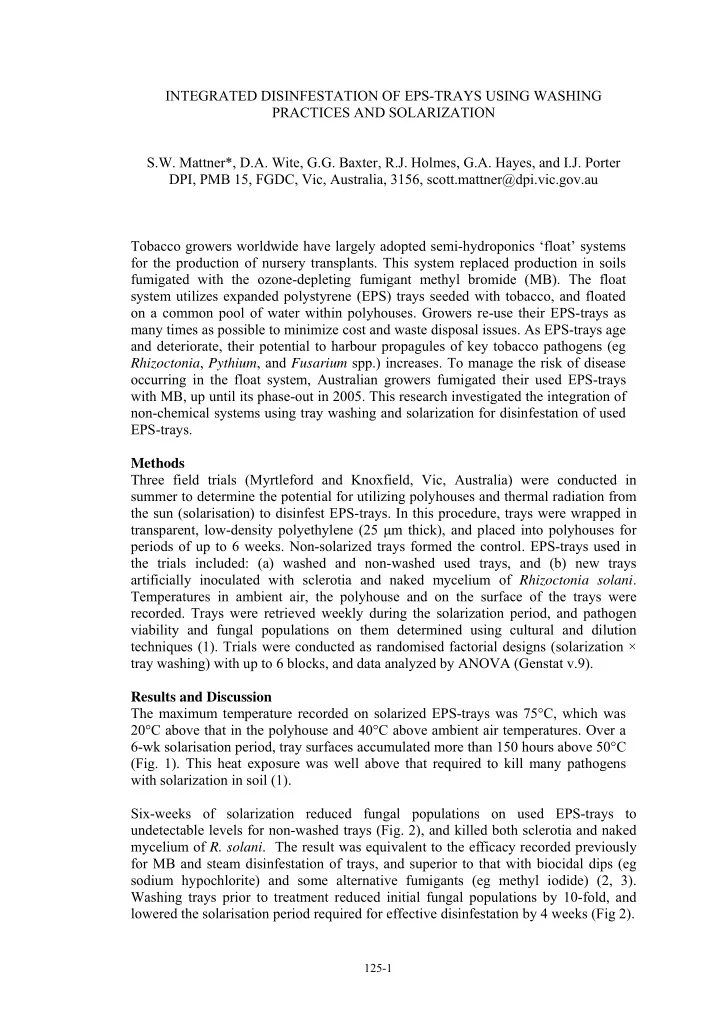

INTEGRATED DISINFESTATION OF EPS-TRAYS USING WASHING PRACTICES AND SOLARIZATION S.W. Mattner*, D.A. Wite, G.G. Baxter, R.J. Holmes, G.A. Hayes, and I.J. Porter DPI, PMB 15, FGDC, Vic, Australia, 3156, scott.mattner@dpi.vic.gov.au Tobacco growers worldwide have largely adopted semi-hydroponics ‘float’ systems for the production of nursery transplants. This system replaced production in soils fumigated with the ozone-depleting fumigant methyl bromide (MB). The float system utilizes expanded polystyrene (EPS) trays seeded with tobacco, and floated on a common pool of water within polyhouses. Growers re-use their EPS-trays as many times as possible to minimize cost and waste disposal issues. As EPS-trays age and deteriorate, their potential to harbour propagules of key tobacco pathogens (eg Rhizoctonia , Pythium , and Fusarium spp.) increases. To manage the risk of disease occurring in the float system, Australian growers fumigated their used EPS-trays with MB, up until its phase-out in 2005. This research investigated the integration of non-chemical systems using tray washing and solarization for disinfestation of used EPS-trays. Methods Three field trials (Myrtleford and Knoxfield, Vic, Australia) were conducted in summer to determine the potential for utilizing polyhouses and thermal radiation from the sun (solarisation) to disinfest EPS-trays. In this procedure, trays were wrapped in transparent, low-density polyethylene (25 μ m thick), and placed into polyhouses for periods of up to 6 weeks. Non-solarized trays formed the control. EPS-trays used in the trials included: (a) washed and non-washed used trays, and (b) new trays artificially inoculated with sclerotia and naked mycelium of Rhizoctonia solani . Temperatures in ambient air, the polyhouse and on the surface of the trays were recorded. Trays were retrieved weekly during the solarization period, and pathogen viability and fungal populations on them determined using cultural and dilution techniques (1). Trials were conducted as randomised factorial designs (solarization × tray washing) with up to 6 blocks, and data analyzed by ANOVA (Genstat v.9). Results and Discussion The maximum temperature recorded on solarized EPS-trays was 75°C, which was 20°C above that in the polyhouse and 40°C above ambient air temperatures. Over a 6-wk solarisation period, tray surfaces accumulated more than 150 hours above 50°C (Fig. 1). This heat exposure was well above that required to kill many pathogens with solarization in soil (1). Six-weeks of solarization reduced fungal populations on used EPS-trays to undetectable levels for non-washed trays (Fig. 2), and killed both sclerotia and naked mycelium of R. solani . The result was equivalent to the efficacy recorded previously for MB and steam disinfestation of trays, and superior to that with biocidal dips (eg sodium hypochlorite) and some alternative fumigants (eg methyl iodide) (2, 3). Washing trays prior to treatment reduced initial fungal populations by 10-fold, and lowered the solarisation period required for effective disinfestation by 4 weeks (Fig 2). 125-1
In a separate trial, continuous solarization of used EPS-trays for up to 10 months did not affect their physical dimensions, although minor discoloration of the tray surface was observed. Solarization of used EPS-trays is an attractive disinfestation method for tobacco growers, as it allows them to utilize their polyhouses during the off-season (summer), and is a cheap and energy-efficient alternative to MB and steam. Furthermore, there are no issues with residual chemicals on trays that sometimes cause phytotoxicity in tobacco seedlings (2). The success of solarization in Australia may encourage other tobacco producing nations to trial solarization as an alternative to MB for disinfestation of used EPS-trays. Integration with other hygiene practices (eg tray handling and storage) might also increase the efficacy of this disinfestation system. References 1. Porter, I.J. (1991). Factors which influence the effectiveness of solarization for control of soilborne fungal pathogens in South Eastern Australia. PhD, La Trobe University, Melbourne, Australia. 2. Baxter, G.G. et al. (2007) Sustainable tobacco production. HAL TB04001. Horticulture Australia Final Report. Sydney, Australia. 3. Gutierrez, W.A. et al. (1997) Sources of inoculum and management for Rhizoctonia solani damping off on tobacco transplants under greenhouse conditions. Plant Disease 81: 604-606. 180 180 Polyhouse Polyhouse Polyhouse 160 160 Tray Surface Tray Surface Tray Surface 140 140 120 120 Hours Hours 100 100 80 80 60 60 40 40 20 20 0 0 1 1 2 2 3 3 4 4 5 5 6 6 Solarisation (weeks) Solarisation (weeks) Figure 1. Cumulative hours above 50°C measured on the tray surface of solarized EPS-trays, and in the polyhouse containing them, over a 6-week period in summer. 125-2
5 5 LSD ( p = 0.05) LSD ( p = 0.05) LSD ( p = 0.05) LSD ( p = 0.05) Total Fungi (LogCFUs+1 per cell) Total Fungi (LogCFUs+1 per cell) 4 4 3 3 Washed, Solarised Washed, Solarised Washed, Solarised Washed, Solarised Washed, Solarised Washed, Solarised Washed, Solarised Washed, Solarised Washed, Solarised Non-Washed, Solarised Non-Washed, Solarised Non-Washed, Solarised Non-Washed, Solarised Non-Washed, Solarised Non-Washed, Solarised Non-Washed, Solarised Non-Washed, Solarised Non-Washed, Solarised Washed, Non-Solarised Washed, Non-Solarised Washed, Non-Solarised Washed, Non-Solarised Washed, Non-Solarised Washed, Non-Solarised Washed, Non-Solarised Washed, Non-Solarised Washed, Non-Solarised 2 2 Non-Washed, Non-Solarised Non-Washed, Non-Solarised Non-Washed, Non-Solarised Non-Washed, Non-Solarised Non-Washed, Non-Solarised Non-Washed, Non-Solarised Non-Washed, Non-Solarised Non-Washed, Non-Solarised Non-Washed, Non-Solarised - - - 1 1 0 0 0 0 1 1 2 2 3 3 4 4 5 5 6 6 Solarisation (weeks) Solarisation (weeks) Figure 2. The effects of solarization and washing on populations of total fungi on EPS-trays over a 6-week period in summer. 125-3
Recommend
More recommend